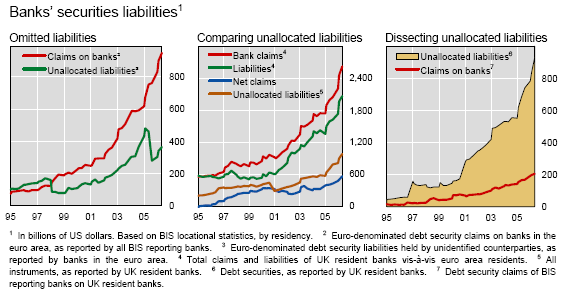Measuring net banking flows: some challenges
(Extract from pages 47-61 of BIS Quarterly Review, December 2007)
Banks' growing use of debt and equity securities markets for funding purposes has made it increasingly difficult to measure the net capital position of one country versus another. The objective of this box is to explain and quantify this issue and to describe one possible procedure for addressing it. The main challenge is that a large fraction of banks' securities liabilities are held by non-banks, which do not report in the BIS banking statistics.
Banks' liabilities are increasingly in the form of debt or equity securities rather than deposits. Such liabilities issued by BIS reporting banks grew from $382 billion at end-1995, or 4% of these banks' total liabilities outstanding, to $4.2 trillion at mid-2007, or 13% of total liabilities. This has generated two related problems which cloud interpretation of the BIS statistics. First, the trading of securities on secondary markets implies that banks cannot identify the holders of the vast majority of their securities liabilities. As a consequence, the liabilities which banks themselves cannot allocate to a particular vis-à-vis country grew from 7% to 10% of the total over the same period. Second, the distinction between international and domestic securities issuance has been blurred over time, thus making it unclear whether a particular liability is cross-border or not. For example, most euro area countries have not reported international euro-denominated debt security liabilities since 1999, implicitly treating such securities liabilities as domestic. However, euro-denominated debt security claims on banks in these countries reported by banks in other countries have been increasing steadily since end-1995, suggesting that much of these securities are in fact held internationally (graph, left-hand panel).
The aggregate indicators of banks' unallocated or omitted liabilities fail to convey the extent to which such liabilities may impair measures of net bilateral positions. For example, the stock of unallocated liabilities of banks in the United Kingdom is large relative to their reported gross liabilities to euro area residents (graph, centre panel). More importantly, these unallocated liabilities are generally larger than the reported net position of banks in the United Kingdom vis-à-vis euro area residents, implying large uncertainty about the true magnitude of this net position.
The bilateral structure of the BIS locational statistics allows for a partial correction of the data. A fraction of the unallocated debt security liabilities of banks in the United Kingdom (currently 19%) are reported as assets by banks elsewhere (graph, right-hand panel) and, thus, allocated according to the residence of these counterparties. However, a similar allocation of the large remaining fraction, which is most likely held by non-bank investors that are not covered by the BIS banking statistics, relies inevitably on an estimate of these investors' geographical distribution. A natural approach towards such an estimate, which is adopted for the main discussion in this special feature, is to assume that this distribution mimics the readily observable geographical distribution of reporting banks' deposit liabilities to non-banks.



